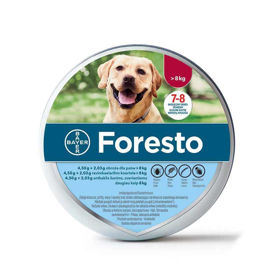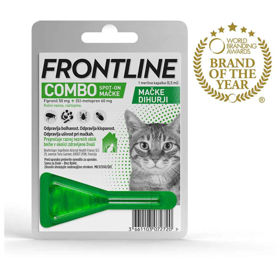Ticks can transfer one or more types of microorganisms to or into your dog with a single bite, allowing a variety of these often harmful microorganisms to work together to release toxins and trigger your dog's immune response.
Some microorganisms spread by ticks, for example, can even help each other to survive in your pet's body, which can cause repeated or chronic infections. Due to diseases spread by ticks, your dog's organs and tissues become infected and can even become inflamed, causing many symptoms and possibly irreversible consequences. In some cases, symptoms may not appear until several weeks after infection.

Untreated tick diseases can damage the dog's kidneys, nervous system, immune system, blood vessels, and heart. In addition, many tick-borne diseases cause problems with the blood, leading to severe bleeding and the inability of the blood to clot properly.
In almost all cases, ticks are not the cause of disease, as ticks become infected with bacteria and protozoan organisms at some point in their life cycle. Ticks then transmit these diseases to dogs through their bite. Tick paralysis is an exception, as toxins in tick saliva cause it.
In the following lines, you can learn about the most common tick diseases in dogs:
Lyme disease
Lyme disease is caused by the bacterium Borrelia burgdorferi and is transmitted by infected black-legged or deer ticks.
Video content: Lyme disease in dogs.

Lyme disease symptoms in dogs may include lethargy, lameness, fever, joint pain or swelling, and possibly enlarged lymph nodes. However, Lyme disease in dogs can be successfully treated.
Bartonellosis
Although Bartonellosis in dogs is less common than some other tick-borne diseases, the symptoms of this disease can be severe. Some of the earliest signs of canine Bartonellosis include intermittent fever and lameness. If left untreated, Bartonellosis can lead to severe conditions such as heart or liver disease.
Rickettian diseases
Ricketti microorganisms are intracellular bacterial parasites that infected ticks can spread. Rickettsia bacteria can cause many dog diseases, including Rocky Mountain spotted fever, ehrlichiosis, and canine anaplasmosis.
Bacterial diseases can be complicated to diagnose. Several tests or types of treatment may be needed before a definitive diagnosis can be made for your dog's observed symptoms.
Rocky Mountain spotted fever.
Rocky Mountain spotted fever is carried by Rocky Mountain wood ticks, brown deer ticks, and American dog ticks. Swollen lymph nodes, joint pain, decreased appetite, and fever are some of the dogs' most common symptoms. Dogs may also experience neurological symptoms such as balance problems or weakness in some cases.
Canine ehrlichiosis
Several ticks can transmit canine ehrlichiosis, including the American dog tick, the brown dog tick, and the Lone Star tick. Symptoms of this disease usually begin about 1 to 3 weeks after infection and may include fever, decreased appetite, nosebleeds, and bruising.
Early diagnosis and treatment are crucial for successful treatment. Treatment can be more demanding in dogs that develop chronic disease symptoms.
Canine anaplasmosis
The most common symptoms of canine anaplasmosis are almost the same as other tick-borne diseases and include lethargy, loss of appetite, stiff joints, fever, diarrhea, and vomiting. In severe cases, however, canine anaplasmosis can cause epileptic seizures in dogs.
Protozoan diseases
Ticks are also carriers of protozoan intracellular parasites. These organisms colonize the dog's red blood cells and cause the protozoan diseases listed below.
Canine babesiosis
The bites of infected brown dog ticks mainly spread canine babesiosis. However, canine babesiosis can also be spread by the bite of an infected dog with contaminated intravenous blood or transmitted from a pregnant dog to her unborn puppies by transplacental transmission.
Canine babesiosis causes the breakdown of red blood cells, which causes the symptoms such as jaundice, pale gums, lethargy, dark-colored urine, and in some cases, general weakness and vomiting.
Hepatozoonosis in dogs
Although canine hepatozoonosis is a tick-borne disease, your pet can contract it if it ingests another infected animal, such as a rodent or bird. Dogs infected with this disease often show mild symptoms or none at all.
Depending on the type of disease, more severe cases can cause symptoms that can seriously affect your pet's mobility, such as muscle, bone, and joint pain. Other symptoms of canine hepatozoonosis include fever, pale gums and skin, and enlarged lymph nodes.
Treatment of tick diseases in dogs
Tick-borne infections are usually treated with broad-spectrum antibiotics. However, recurrent tick-borne diseases can be complicated to overcome. Therefore, even after your dog appears to have recovered, regular blood tests are recommended to help detect recurrences early so that treatment can prevent the condition from becoming more serious.
Video content: how diseases in dogs can affect them?

Limiting your dog's exposure to ticks is the key to preventing disease. Ticks are found in grassy, wooded, and sandy areas. They find their way to the animal by climbing to the top of a leaf, grass, or low tree, waiting for their sensors to detect an approaching animal on which they can descend. Therefore, keeping animals in front of or under dense brush reduces their exposure to ticks.
Many products are also available that can kill ticks and prevent disease transmission. For example, effective monthly preventatives are usually applied to the skin on the back of the neck and are a convenient method of controlling these external parasites. In addition, there are chewable products and anti-tick collars.
Protect your dog from tick-borne diseases.
- Learn about ticks and diseases in your area.
- Use preventative measures, including topical medications and tick collars. Be aware that tick repellants do not prevent disease transmission; reduce the risk by reducing the burden of ticks in the dog's environment.
- If your dog spends time outdoors, check it daily for ticks. Also, pay attention to the head, ears, shoulders, and upper legs.
- As soon as it is found, remove it with tweezers so that the tick is safely extracted from the dog's skin. Avoid squeezing the tick to prevent transmission of the tick's body fluids.
- Never spray your dog with human tick repellants, as these chemicals are toxic if ingested by you or your dog.
- Consult your veterinarian about annual testing for tick-borne diseases. Testing is fast and efficient and can save expensive veterinary costs, as tick-borne diseases are not detected early.
- If your dog shows symptoms of tick-borne disease, the test may initially be negative. This is mainly because most tests measure the presence of antibodies against a pathogen, and antibodies take some time to reach measurable levels in the blood. Instead, discuss polymerase chain reaction (PCR) diagnostic testing for the pathogens.
Frequently asked questions about tick diseases in dogs.
Customer question:
Which products are best for preventing ticks in dogs?
Pharmacist's response:
The best flea treatments are those that are safe for your dog. Avoid products that contain allergens and aggressive chemicals that can harm your dog's health. Check with your vet which ingredients are safe and practical at the same time.
While topical medications work directly on fleas, oral or chewable tablets go into the fleas themselves after they bite your pet. This type of flea tablet (usually) with a veterinary prescription is very effective.
If necessary, consult your veterinarian before using any new product on your dog. With so many different products on the market, it's hard to choose the best anti-flea medicine, but it should be the case that you always buy these types of products primarily in a pharmacy. Always ask your vet for advice to ensure you choose the best treatment for your dog.
Customer question:
What is Lyme disease? Is it deadly?
Pharmacist's response:
Lyme disease is caused by a spirochete (type of bacteria), Borrelia burgdorferi. It is transmitted to dogs by the bite of an infected tick. When the bacterium enters the bloodstream, the microorganism is transferred to many body parts and localized in the joints or kidneys.
Typical symptoms in dogs include:
- fever
- loss of appetite
- reduced energy
- general stiffness, discomfort, or pain
- joint swelling
- limping
If your dog shows any symptoms of Lyme disease, contact your veterinarian. Lyme disease can be treated, but if left untreated, it can lead to kidney failure or even death. Untreated Lyme disease can also cause long-term heart and neurological problems.












 Facebook
Facebook
 Instagram
Instagram
 info@moja-lekarna.com
info@moja-lekarna.com

